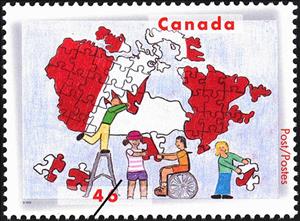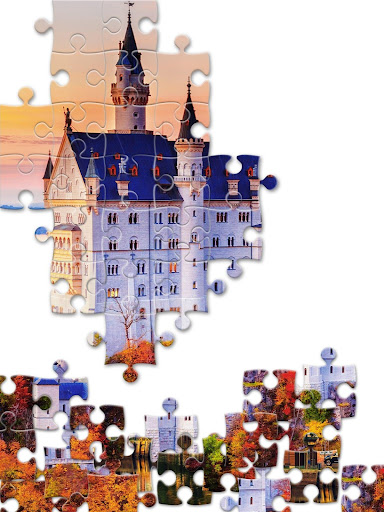Stamp: Children of Different Races Putting a Jigsaw Puzzle Map of C (Canada 2000)
Children of Different Races Putting a Jigsaw Puzzle Map of C (Canada 2000)
01 July (Canada ) within release Stampin' the Future goes into circulation Stamp Children of Different Races Putting a Jigsaw Puzzle Map of C face value 46 Canadian cent
| Stamp Children of Different Races Putting a Jigsaw Puzzle Map of C in catalogues | |
|---|---|
| Stamp Number: | Sn:CA 1861 |
Stamp is horizontal format.
Also in the issue Stampin' the Future:
- Stamp - Astronauts in Space, a Rainbow and a Canadian Flag face value 46;
- Stamp - Three People about to Travel from Earth to a Distant Planet face value 46;
- Stamp - Children of Different Races Putting a Jigsaw Puzzle Map of C face value 46;
- Stamp - Two Space Travellers, one White, one Black, Seated Side-by-s face value 46;
- Se-tenant - Stampin' the Future face value 4*46;
Stamp Children of Different Races Putting a Jigsaw Puzzle Map of C it reflects the thematic directions:
A flag is a piece of fabric (most often rectangular or quadrilateral) with a distinctive design that is used as a symbol, as a signaling device, or as decoration. The term flag is also used to refer to the graphic design employed, and flags have since evolved into a general tool for rudimentary signalling and identification, especially in environments where communication is similarly challenging (such as the maritime environment where semaphore is used). National flags are patriotic symbols with varied wide-ranging interpretations, often including strong military associations due to their original and ongoing military uses. Flags are also used in messaging, advertising, or for other decorative purposes. The study of flags is known as vexillology, from the Latin word vexillum, meaning flag or banner.
A map is a symbolic depiction emphasizing relationships between elements of some space, such as objects, regions, or themes. Many maps are static, fixed to paper or some other durable medium, while others are dynamic or interactive. Although most commonly used to depict geography, maps may represent any space, real or imagined, without regard to context or scale, such as in brain mapping, DNA mapping, or computer network topology mapping. The space being mapped may be two dimensional, such as the surface of the earth, three dimensional, such as the interior of the earth, or even more abstract spaces of any dimension, such as arise in modeling phenomena having many independent variables. Although the earliest maps known are of the heavens, geographic maps of territory have a very long tradition and exist from ancient times. The word "map" comes from the medieval Latin Mappa mundi, wherein mappa meant napkin or cloth and mundi the world. Thus, "map" became the shortened term referring to a two-dimensional representation of the surface of the world.
Biologically, a child (plural: children) is a human being between the stages of birth and puberty. The legal definition of child generally refers to a minor, otherwise known as a person younger than the age of majority. Child may also describe a relationship with a parent (such as sons and daughters of any age) or, metaphorically, an authority figure, or signify group membership in a clan, tribe, or religion; it can also signify being strongly affected by a specific time, place, or circumstance, as in "a child of nature" or "a child of the Sixties". There are many social issues that affect children, such as childhood education, bullying, child poverty, dysfunctional families, child labor, hunger, and child homelessness. Children can be raised by parents, by fosterers, guardians or partially raised in a day care center.
A puzzle is a game, problem, or toy that tests a person's ingenuity or knowledge. In a puzzle, the solver is expected to put pieces together (or take them apart) in a logical way, in order to find the solution of the puzzle. There are different genres of puzzles, such as crossword puzzles, word-search puzzles, number puzzles, relational puzzles, and logic puzzles. The academic study of puzzles is called enigmatology.




